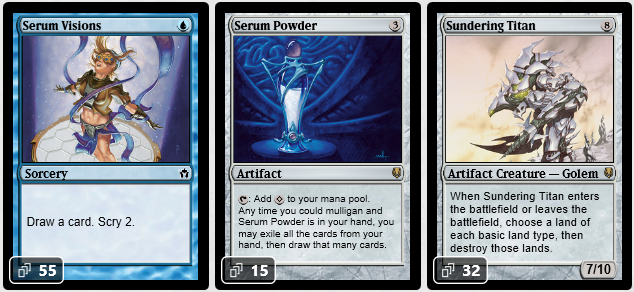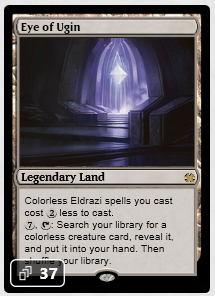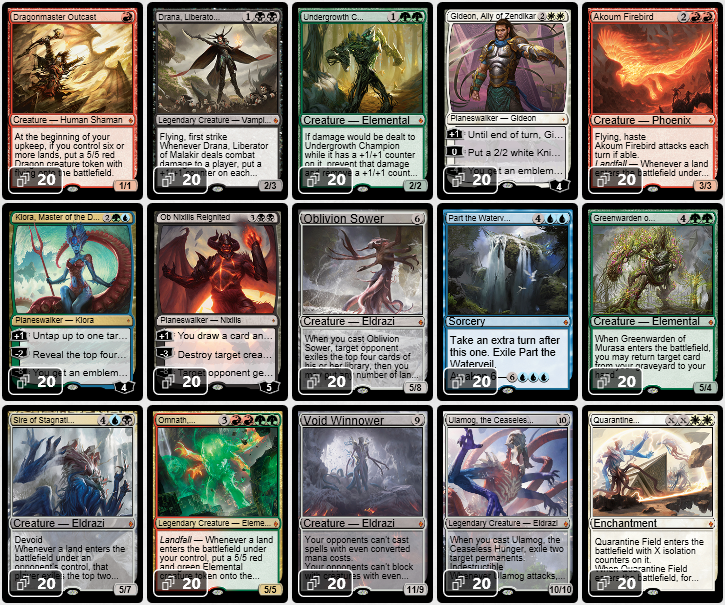Are you a Quiet Speculation member?
If not, now is a perfect time to join up! Our powerful tools, breaking-news analysis, and exclusive Discord channel will make sure you stay up to date and ahead of the curve.
Welcome back for another week of High Stakes Bankroll Managment on MTGO. I thought I would start today by giving you a little heads up on my baseline strategy when it comes to investing with such a large bankroll.
When you decide to invest in any positons on MTGO there are a least two things you should consider:
- The size of your bankroll---e.g. make sure you are not buying into a position that would be too big a share of your bankroll.
- The number of copies for any given position---e.g. you can't buy 500 copies of your target positions as it might be a nightmare to sell so many at a profit.
In other words, always buy positions that make sense in the context of your bankroll, both in terms of price and number of copies. With such a big bankroll I could buy hundreds of copies of pretty much anything without endangering my bankroll. However it could be very tempting to buy thousands of copies of every spec I go for, and this is what I don't want to do.
My baseline for any potential specs with this bankroll is the following---200 tix max and/or 50-60 copies max. As you can see, I don't adhere to these slavishly. I also have a price limit in mind when buying cards, which often enough limits the number of cards I'll purchase in the end. There are also a fair amount of exceptions where I'm willing to exceed the max tix and copies figures.
Boosters and full sets are two spec categories where these limits don't apply. For regular cards, if the price per copy is high I'll be willing to invest more tix, such as for Tarmogoyf, Snapcaster Mage and more recently MM2 Eye of Ugin.
Another exception were the Magic Origins painlands (which I discuss in more detail below). Things didn't fare as I expected with these lands, but when I pulled the trigger all indicators pointed to a spec that could not fail.
One pillar of that assumption was that the M13 checklands still saw a nice price increase during their Standard period despite being printed in the previous three core sets! Standard cards are also much more liquid and with very low spreads. For these reasons I raised my total limits on all of the five painlands.
Managing a small or a big bankroll is not very different in the end (although you will probably need more time with a big bankroll). The main difference is that you can go big and deep if you want to with a big bankroll.
Here is the current state of the bankroll.
Buys This Week
I'll start this week with couple of additional buys from Mirrodin block following the end of flashback drafts. Prices got down a bit and I upped my copies for Serum Visions, Serum Powder and Sundering Titan. All three cards, as well as other staples from this block, have already rebounded nicely as of today.
Buying 37 copies of Modern Masters 2015 Eye of Ugin was only based on the observed discrepancy between the Worldwake version, priced way above 20 tix, and the MM2 version, priced around 11 tix when I purchased my copies. As of writing, available supplies of Eye of Ugin are still fairly low.
The newly introduced Eldrazi decks seem poised to be a real contender in Modern and they're using a full playset of the legendary land. My bet here is that prices of both versions should adjust and hopefully converge around 15 tix. I'm seeking a small percentage profit here.
Ideally, I would prefer to flip these at my target price (~13.5 tix) before Pro Tour Oath of the Gatewatch. If I don't, then I'm hoping for Eldrazi decks to show some results at the upcoming PT.
I have started accumulated full sets of Battle for Zendikar this past week. The release of OGW on MTGO caught players' attention and tix, resulting of a decrease of just about everything else.
Note that this might not be the absolute best buying price for BFZ full sets---they actually were around 60 tix earlier this December. They might also get cheaper between now and the release of Shadows over Innistrad, but not by much.
Nonetheless I want to start accumulating full sets now that I know the price is dipping. I'll probably buy a total of 30 BFZ full sets for now and be ready to buy 15-20 more if the price drops further in the coming months.
Sales This Week
Although this guy could go higher I was aiming for a 2 tix selling price. This past week buying prices crossed the 2 tix bar and I started unloading copies. Buying prices didn't keep up with this price and are now back in the 1.4 - 1.8 tix range. Not a problem; I'll wait for the next price hike to sell my 15 other copies of Master of the Pearl Trident.
On My Radar
Buying up to 30 full sets of Battle for Zendikar is on the top of my list of things to do this week. Whether prices decline further, stabilize, or rebound, I'll be buying these sets now. With the new set rotation structure and the new draft structure, e.g. 2 OGW and 1 BFZ, it's not clear to me whether BFZ sets will get cheaper in the following months. Without much confidence in what will happen next I prefer to buy now.
With Pro Tour Oath of the Gatewatch taking place this weekend, I'll certainly be looking to sell several of my Modern positions. Many of those I'm currently holding are already getting close to my target selling price---it would not take much from the PT to up prices just a little bit so I can sell them.
Alternatively I'll also be trying to take advantage of cards that don't meet everyone's expectations this weekend.
With the recent ban of the elephant in the room---Splinter Twin---the format has changed and will certainly change again in the following months after this PT. Cards that dip for lack of appearance during this PT might be those showing up next in a metagame trying to find its bearings. This is a great situation for speculators where buying and selling opportunities happen simultaneously.
Questions & Answers
Arcum Dagsson & Other Odd Cards
Good question! It doesn't make a lot of sense, does it? Arcum Dagsson was among the cards, from bulk to just below bulk, that I wanted to invest in as long-term investments. The idea was that these cards, and Arcum in particular, have a singular effect that could someday be incorporated into a Modern deck and thus see a nice price raise. Nourishing Shoal is a great example of such cards.
Since the supply of Coldsnap cards is rather limited, even a slight increase in demand has the potential to dramatically increase the price. My bet with Arcum Dagsson was meant to be for the long run with almost no risk and for a potentially high reward.
The recently introduced Modern Flashback Draft Year kind of messed up the initial idea of buying bulk cards and waiting for a spike. That's why there aren't that many Arcum-like positions in my portfolio.
As for Arcum himself, I'm not sure yet if I'll be trying to sell it before Coldsnap flashback drafts (knowing that my selling price will be very low anyway) or if I'll just be waiting with my current copies since this position represents a tiny fraction of my bankroll. After all, a spike can still happen and from this optic Arcum's current price doesn't really matter.
Dealing With 900 Copies
Buying more than 200 copies of any position (with the exception of boosters) will only happen on very rare instances with my investing strategy.
One situation I could see leading to buying hundreds of copies of a card would be betting on bulk Modern rares with the potential to spike sometime in the future. Such positions would only require a couple dozen tix for 300 copies or more. The idea of such a bet is “all or nothing.” Either the cards spike to 1 or 2 tix or they stay bulk forever, and I would consider such an investment dead unless a spike occurs.
Let’s come back to the painlands. To start with I had decided to go deep on these because they constituted, in my opinion, the surest bet you could find on MTGO at that time. It didn’t pan out as expected but they're still in the winning category and from here they can only improve. Standard cards are also more easily tradable and with lower spreads, which makes it easier to sell a larger number at a better profit.
Acquiring all of these copies was not done in two or three days but over several weeks. I had decided on a threshold price I was willing to pay back in September and I accumulated 40-60 copies every day, twice a day sometimes, when the selling prices reached that price. Bots are always pretty stocked with Standard cards and since the painlands were not really in demand prices didn’t move much. Prices actually went down when it became obvious they would not be big players in the current Standard metagame.
The buying strategy is fairly simple. Between MtgoLibrary Bots, Mtgotraders, Goatbots and others I bought one playset at a time, and more than one playset when authorized with bots such as Goatbots and Mtgotraders.
Later in November, as painland prices got to their lowest I decided to reinforce by ~150 copies the painlands that had lost the most---Shivan Reef, Battlefield Forge and Yavimaya Coast. I was and still am convinced that the rotation of Khans of Tarkir and its fetchlands will help the ORI painlands rise in demand. So with prices cut in half and with enough tix available to my bankroll, I bought more lands.
Selling will be a slow process as well. I won’t be waiting for any painland to hit 5 tix before selling though. Considering my large positions I’m likely to start selling as soon as buying prices hit 2 tix, or 1 - 1.5 tix for Yavimaya Coast. This may happen fairly soon actually. It will probably be a matter of selling 30-40 copies every other day or so.
At the end of the day if I double up on the 2700 tix I invested in the painlands I would consider it a success. If I can sell each of them for 4 tix a piece, I’ll be sitting on more than 13,000 tix and my bankroll will have progressed by more than 50% with only five positions, the sure bet I was talking about six months earlier.
Thank you for reading,
Sylvain Lehoux











Hi Sylvain,
I’ve seen your write that you look for a potential profit >50% on your specs. In other words, that the peak in a card’s price history is at least 50% greater than that the card’s current value.
My question is, what’s your method for finding these cards? Do you look up cards one at a time to check if they meet your metric? Do you see a card’s current price and think “Man, that seems low” and then check it’s price history? How do you efficiently identify your targets?
Thanks,
Jesse
Hi Jesse,
I reply in details in my next High-Stakes article. But maybe you don’t have an Insider account, I’ll give the headlines so you don’t have to wait one week.
You’re right about the 50%. I’m pretty much always looking to buy into Modern cards that have at least a 50% increase margin to their historical Modern height. I very rarely bet on “potential” although that could be a viable strategy.
Mtggoldfish movers and shakers are my best friends, I check them very often so I know what’s moving what’s not and I often click on cards just to refresh my memory on price history. Looking at the Total Modern Format price index you can sort them by about anything. Looking at the top losers (mostly) or gainers can give you an idea of what’s good to buy at any given time.
With time, I know a lot prices almost by heart.
Thanks so much, Sylvain. I got my Insider account only a week ago, and now I’m understanding how your articles are released to the Inside first.
Looking forward to your details in the next article, but this comment makes a lot of sense. I’ve seen the Movers and Shakers before, but never really looked at them as a means to make profit.
I appreciate your comment, and really like your projects and subsequent articles. Fantastic and intriguing stuff, can’t wait to read more.
Cheers,
Jesse